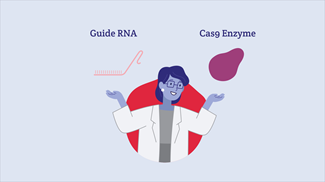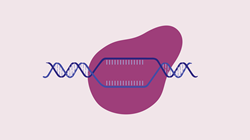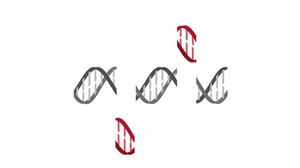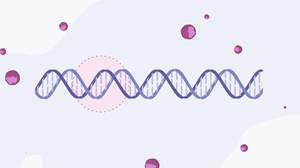Gene editing has gained a lot of attention over the past few years, but that may leave you wondering: what exactly is it? Gene editing aims to be a one-time therapy that directly edits pieces of DNA within the cell. It's considered a type of gene therapy, which is the use of genetic material to treat or prevent disease.
What’s the Difference: Gene Therapy vs. Gene Editing
_1.aspx?width=350&height=350) Simply put, gene editing is a type of gene therapy. They both target the cause of disease, such as a variant or mutation in a gene, by using genetic material to treat or prevent disease. Most gene therapy approaches work by delivering a working gene into a cell using a viral vector as a carrier, but the viral genes have been removed so only the intended (therapeutic) genes are delivered. When the vector carrying the working gene enters the cell it provides new instructions to produce either more or less of a certain protein depending on what is needed. For the body to function properly it is essential that the right number of proteins are produced. Gene editing has a similar goal but differs by delivering genetic material that can directly edit pieces of DNA within a cell. This changes the instructions the DNA encodes for to correct the protein produced by the DNA and restore proper cell function.
Simply put, gene editing is a type of gene therapy. They both target the cause of disease, such as a variant or mutation in a gene, by using genetic material to treat or prevent disease. Most gene therapy approaches work by delivering a working gene into a cell using a viral vector as a carrier, but the viral genes have been removed so only the intended (therapeutic) genes are delivered. When the vector carrying the working gene enters the cell it provides new instructions to produce either more or less of a certain protein depending on what is needed. For the body to function properly it is essential that the right number of proteins are produced. Gene editing has a similar goal but differs by delivering genetic material that can directly edit pieces of DNA within a cell. This changes the instructions the DNA encodes for to correct the protein produced by the DNA and restore proper cell function.
How it Works
 There are various gene editing approaches currently being researched. That means there are different types of gene editing and all of these may work a little differently. For an example, we’ll discuss CRISPR Cas9, which uses two core components. The first component is a small piece of RNA, called a guide RNA, that finds the sequence of DNA code to be edited. The second component is a protein, called a Cas enzyme or nuclease, that has the ability to cut and make the edit at the DNA location defined by the guide RNA. Next, the cell’s natural DNA repair process happens—making the desired change permanent. Not all types (TALENs, Zinc Finger Nucleases, etc.) of gene editing use the guide RNA or the scissor-like feature of the Cas9 enzyme.
There are various gene editing approaches currently being researched. That means there are different types of gene editing and all of these may work a little differently. For an example, we’ll discuss CRISPR Cas9, which uses two core components. The first component is a small piece of RNA, called a guide RNA, that finds the sequence of DNA code to be edited. The second component is a protein, called a Cas enzyme or nuclease, that has the ability to cut and make the edit at the DNA location defined by the guide RNA. Next, the cell’s natural DNA repair process happens—making the desired change permanent. Not all types (TALENs, Zinc Finger Nucleases, etc.) of gene editing use the guide RNA or the scissor-like feature of the Cas9 enzyme.
Learn more about the various types of technology being researched:
 Gene editing can be delivered into cells using in vivo or ex vivo methods. In vivo means the gene editing components are delivered directly into the body to make edits within the cells. Ex vivo means the cells are first removed from the patient and then edited in a specialized laboratory and returned back to the patient’s body. To address different types of diseases and their cause, there are a few common gene editing approaches used:
Gene editing can be delivered into cells using in vivo or ex vivo methods. In vivo means the gene editing components are delivered directly into the body to make edits within the cells. Ex vivo means the cells are first removed from the patient and then edited in a specialized laboratory and returned back to the patient’s body. To address different types of diseases and their cause, there are a few common gene editing approaches used:
-
Gene integration - For diseases where not enough protein is produced gene editing can introduce corrections through gene integration. This means that the correct DNA sequence is added into the genome so that it can produce functional proteins.
-
Gene activation - For diseases where not enough protein is produced gene editing can make an edit to activate a previously inactive silent gene.
-
Gene knock out - For diseases where a faulty gene may cause too much of a protein or dysfunctional proteins to be produced, gene editing can be used to silence or “knock out'' certain genes in a cell. This approach alters or removes the problematic DNA sequence entirely.
Research Pipeline
Gene editing approaches are currently being carefully investigated in preclinical studies and clinical trials. Clinical trials are a required part of the research process that aim to understand the way a drug or treatment will interact with the human body and whether it is safe and effective. Preclinical studies are an even earlier stage of research that test the safety and effectiveness of a treatment in animal or cell-based models before proceeding with a human clinical trial. Clinical trials may differ on many aspects of their design. If you are considering an investigational gene therapy through a clinical trial, it would be best to discuss your options with a healthcare provider or a member of the clinical trial research team.
To stay up to date on open clinical trials in the U.S. or globally, visit the ASGCT Clinical Trials Finder and search for gene editing using the "modality" filter.
Disease Applications
 Gene editing therapies have seen positive results from early clinical studies. So far, treatments are being investigated for individuals with:
Gene editing therapies have seen positive results from early clinical studies. So far, treatments are being investigated for individuals with:
-
Sickle cell disease (blood disorder)
-
Certain rare inherited eye disorders that can cause blindness
-
HIV Type 1 (immunodeficiency disease)
-
Transthyretin (ATTR) amyloidosis (disease that affects the heart and nervous system)
-
Multiple myeloma (blood cancer)
-
Cystic fibrosis (disease that affects the lungs and digestive system)
Risks and Challenges
As with any medical intervention, there are potential risks that are being thoroughly researched in preclinical studies and clinical trials. Therapies being studied in clinical trials are not a guaranteed cure and cannot guarantee beneficial results. There is always a chance that the investigational treatment may not work. In the event a person is not satisfied with the outcome, the person may not be given another dose of the gene editing therapy. In addition, participating in a clinical trial may prevent future participation in other trials or from receiving other types of treatments. Gene therapy, including gene editing, can be an alteration for the lifetime, so people should be aware that there could be long term effects (both good or bad) that are not known at this time.
 Since gene editing makes changes directly to the DNA, there are some unique risks that could change the intended effects of the therapy and result in short and long term side effects. These challenges are being carefully studied in the hopes that future therapies will become highly accurate and safe.
Since gene editing makes changes directly to the DNA, there are some unique risks that could change the intended effects of the therapy and result in short and long term side effects. These challenges are being carefully studied in the hopes that future therapies will become highly accurate and safe.
-
Unintended gene modifications - When editing a DNA sequence, unintended gene modifications or chromosome rearrangements may possibly occur, especially if multiple edits are being made at the same time.
-
Off-target editing events - There’s also the risk, depending on the guide sequences, of modifying DNA locations that are not the desired target site, which are known as “off- target” editing events.
Benefits & Outlook
Like any gene therapy, gene editing aims to be a one-time treatment with lasting positive effects that slow or stop disease progression for a lifetime. However, there is no guarantee, and this change is permanent. We are still very early in the development of gene editing and the process is far from complete. While gene editing therapies are still somewhat within their infancy stages the development that we have seen over the past few years promises a future that looks very bright for hundreds of thousands of patients and their caregivers. Ultimately, we hope that if gene therapy is received earlier in the course of disease, it will also have the potential to stop damage before it occurs.
Was this information helpful? If so, please share! All ASGCT Patient Education resources are free to use. You can reference the media kit to share posts on social media, embed the video, or simply link to this page! Please credit the American Society of Gene and Cell Therapy or tag @ASGCTherapy.